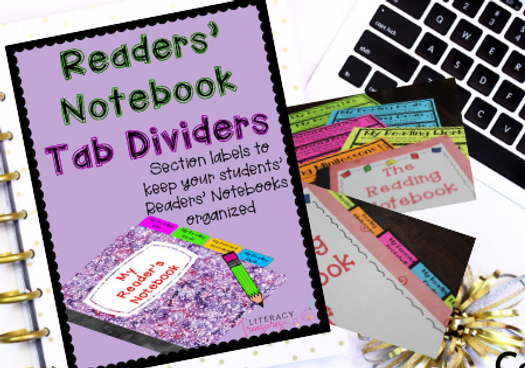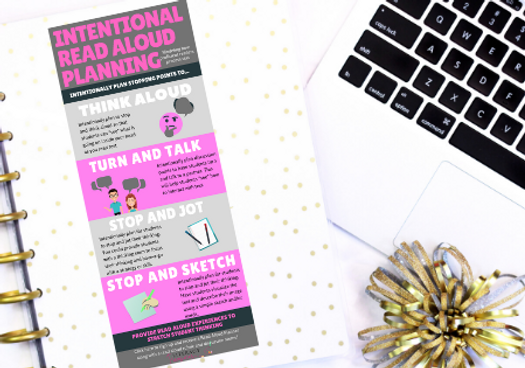Every teacher has an instructional toolkit or what some might call a bag of tricks. A little 'grab bag' to pull from when a teachable moment comes to light. Mine was a file cabinet, a closet with baskets overflowing with random items, and a series of chaotically organized binders.
Teaching is HARD!
Teaching takes a LOT of time…personal time!
Teaching takes energy...lots of energy!
That's why this one is all about packing your instructional toolkit one resource at a time.
Let's get straight to tips, tricks, & strategies to pump up your literacy instruction, refresh what you are already doing and bring to light the inspiration you might need to keep moving forward in building strong readers and writers.
++++++++++++++++++++++++++++++++++++++++++++++++++++++++++++++++++++++
So let’s jump right into adding a few tools to your instructional toolkit from the Literacy Treasures FREE Toolkit.
Readers' Notebook Tab Dividers
A reader’s notebook IS a reader’s toolkit. Something a reader uses to record new learning, jot notes about their thinking and get guidance from while independent reading.
The Readers’ Notebook Tab Dividers: Section labels that are ready to print and go for creating Readers' Notebooks.
Within this print and go resource, you can decide which sections you want your readers to have and get those organized into your readers' notebooks.
Think of this as an organizational dream!
Evaluating Student Reading Artifacts for Growth Possibilities
This little cheat sheet has guiding questions to use while you are reviewing student reading artifacts for growth and possibilities for improvement. When you are looking through student work or informal assessment tools, it’s important to know what you are looking for.
This little tool provides guiding questions for informally assessing stop and jots about reading, longer written responses, running records, conferring notes, engagement inventories, interest surveys and how readers engage in conversations about books.
I know it sounds simple, just guiding questions, but it was always helpful to have these little thought provokers jotted down and this little cheat sheet was my answer!
Exit Tickets: A Cheat Sheet for Analyzing and Assessing Student Exit Slips
With this, you will find 3 actionable steps for reviewing exit slips or quick written responses to determine the next steps for your instruction.
-
Step one: Divide the exit tickets/student responses into 3 groups that represent 3 different levels of understanding.
-
Step Two: ask yourself a couple of guiding questions about those groups.
-
Step Three: Determine your next Instructional actions. This step provides tips and ideas to follow regarding your current instruction based on which level of understanding the majority of your students fall under for that specific concept or skill.
This little cheat sheet is a gold mine and time saver for informally assessing the little nuggets of gold your readers and writers are giving you at the end of a lesson. (or your mathematicians, historians or scientists…just sayin)
Intentional Read Aloud Planning Tool
Read aloud is crucial for any age group. I’ve had high school and middle school teachers tell me that their students love it when the teacher reads aloud.
It’s not just an elementary thing. That’s why it’s essential to have a read-aloud plan.
The Intentional Read Aloud Planning Tool is a little infographic reminder of the kinds of experiences that readers should be experiencing during a read-aloud.
Read aloud is more than just a 'sit and git' experience. Read aloud is where the proficient reader in the room models what proficient readers do and nudges readers into trying out proficient reader strategies.
This reading experience can frontload your future instruction with intentional stopping points for you to think aloud or intentional thinking stems to have readers turn and talk for a minute, along with intentional stopping points to jot or sketch out a quick thought or reaction.
These intentional read-aloud practices will show readers what a proficient reader does each and every time they encounter a text.
Text Dependent Analysis Plan for Building Stop and Jots Into Analytical Written Reading Responses
This little tool is more of a 'big picture' planning guide or outline. It will guide and inspire your curriculum planning to help your readers build their skills towards writing those longer responses.
Your readers (and writers) need guidance and a full understanding of how to take their little stop and jots from independent reading and use those to create longer written responses.
Readers need a variety of reading experiences throughout the school year to help them build those jots into longer written responses.
This little curriculum planning tool is a great visual reminder to keep handy as you are planning lessons.
BCQ ~ Browse, Connect & Question: A Prereading Strategy Reading Toolkit Minilesson
BCQ is a prereading strategy that makes the prereading process visible to readers.
This strategy can be introduced at the beginning of the school year during a Readers' Workshop launch and then revisited throughout the year as needed in small groups or with individual students. Sometimes the whole group will need a refresher as they start reading increasingly difficult texts.
Browse Connect and Question seems like an obvious and unnecessary strategy to teach readers, but so many readers at all age groups and levels need to be reminded of this before they begin reading a book or even choosing a book.
It's important for readers to see the reading process at work as they apply strategies within their self-selected texts. What seems obvious to a proficient reader isn't always 'clear as day' for developing readers.
Try out the BCQ: Browse, Connect and Question strategy with your readers right now! Grab this free little minilesson that is all ready for you to print and go! It's available in the Literacy Treasures FREE Toolkit.
Literacy Engagement Charts Planning Tool
Are you interested in helping your readers build comprehension?
Do you want them to revisit texts to strengthen understanding and make interpretations?
Consider using Literacy Engagement Charts - a tool that bridges literal and inferential understandings for readers.
Reading and comprehension can be challenging, but revisiting texts is key to building layers of meaning and supporting interpretations. Revisit text to reread, clarify confusions, fill gaps, dig deeper, and support interpretations.
Every teacher has an instructional toolkit or what some might call a bag of tricks—that little 'grab bag' to pull from when a teachable moment comes to light.
The previous tools were simple cheat sheets and checklists to save you time and energy as you prepare for your readers and writers.
Use the Literacy Treasures FREE Toolkit to pack your instructional toolkit with one or two or ALL of these quick little timesavers. Put these tips, tricks, & strategies in your toolkit to pump up your literacy instruction, refresh what you are already doing and bring to light the inspiration you need to keep moving forward in building strong readers and writers.
Until next time...








